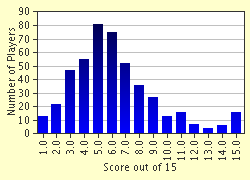Quiz Answer Key and Fun Facts
1. The scale for estimating tornado strength is the Fujita scale. What specifically is used to determine the rating of the tornado?
2. The state with the most tornadoes annually is:
3. The tri-state tornado was the deadliest tornado ever to hit the US, moving through Missouri, Illinois and Indiana. How many people were killed?
4. On the Fujita Scale, a tornado rated F3 would have what range of wind speeds?
5. Tornado activity begins in late winter and migrates in what direction?
6. What is the distinguishing feature of a supercell thunderstorm?
7. CAPE and LI are indices which are used to determine:
8. If a tornado is moving east at 30 knots and the tornado's rotational speed is 150 knots, what is the net wind speed on the northern edge of the tornado if the tornado is rotating counter-clockwise?
9. Prior to 2010, in the USA, which of these met the criteria for a severe thunderstorm?
10. Which of the following synoptic scenarios is not favorable for severe weather formation?
11. Which thunderstorm component kills the most people each year?
12. Which of the following conditions is not favorable for large hail?
13. Which thunderstorm type is also known as a steady-state thunderstorm?
14. Which type of supercell is most likely to develop into a squall line during its later stages?
15. Which radar algorithm is used to determine hail threat?
Source: Author
ksuweatherman
This quiz was reviewed by FunTrivia editor
crisw before going online.
Any errors found in FunTrivia content are routinely corrected through our feedback system.

